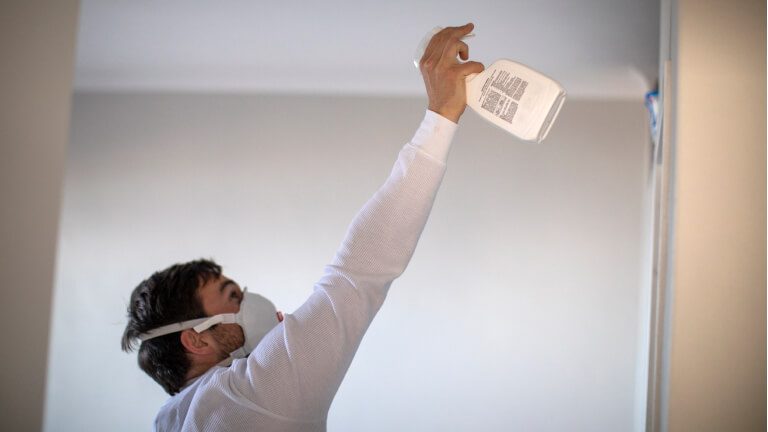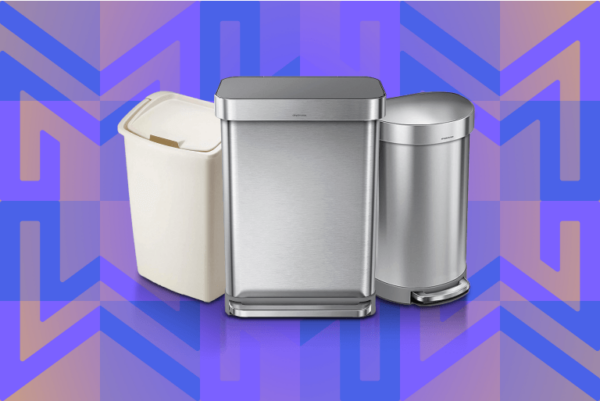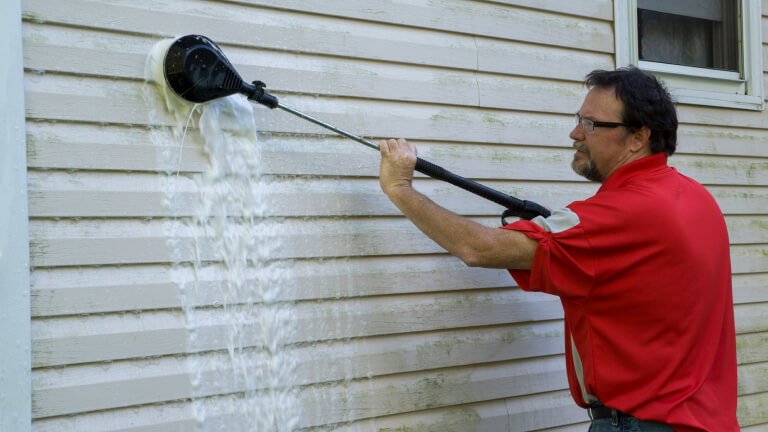Important Tips for Safe and Effective Mold Removal

The products featured here are independently selected based on thorough research from our editorial team. If you buy something through links on our site, we may receive a commission.
If there are sections of your home that are damp and unventilated, mold can take hold in only a day or two. It’s important to eliminate mold for the health of both your home and your family. So, following especially rainy weather or a flood, make sure to check for and remove mold before it seeps into insulation, drywall, and wood.
What causes mold?
Before learning how to address a mold problem, you need to understand its source. Light, tiny mold spores can be found anywhere in unfiltered air, but mold is most prone to grow (and turn into a health problem) when the spores settle on damp surfaces. Often, mold first appears as dark spots that expand as mold colonizes. Poorly ventilated areas are most vulnerable. That’s why, for example, mold on the underside of carpet or in your walls is a concern.
Is mold dangerous?
It’s common to have an allergic reaction to mold when you come into contact with it. Reactions can range from mild to more severe, depending on your sensitivity to allergies. Inhaling mold spores or touching mold can irritate your eyes, nose, throat, skin, and lungs. Contact with mold can be especially harmful to people with asthma.
How to remove mold from every part of your home
Adequate ventilation is crucial for do-it-yourself mold removal anywhere in your home. Position a wall fan in an open window to promote proper airflow. And for safety’s sake, use a respirator and other protective gear.
How to remove mold from carpet
It’s vital to dry out the wet carpet before mold takes hold. Use a utility knife or carpet knife to cut out any contaminated carpet. Wash concrete sub-flooring using tri-sodium phosphate (TSP) or another heavy-duty cleaner. Use thick, 6-mil plastic and duct tape to contain the moldy carpet. Bag other debris in large, thick contractor bags.
How to remove mold from wood
Sometimes it’s possible to simply spray anti-fungal agents on wood walls. But for more serious infestations, you will have to clean the wood. If the wood is painted, use soap and water to clean it. If it’s not, go ahead and use a mixture of bleach and water. After you’ve cleaned the wood wall, seal it with an oil-based primer or a pigmented shellac. Remember that proper ventilation is important when removing mold from wood, so leave windows open and place a fan to blow on your wall while it’s drying.
How to remove mold from walls
When you consider how to clean mold from walls, start by determining the extent of the damage. Open up a small wall with a screwdriver. Remove any drywall and insulation you suspect of harboring mold and remove any trim in affected areas. Use a drywall saw to cut out any areas with suspected mold infiltration. Install new insulation, and replace the drywall. Seal and sand the drywall seams, then paint. Nail the trim back in place.
If it seems like the mold has not infiltrated the drywall, spray the exterior of the wall with bleach or white vinegar. Let the solution dry completely.
How to remove mold from tile and grout
Grout is often porous and textured, which complicates mold removal. But there are a few different ways to remove mold from grout. For more stubborn infestations, try a baking soda paste composed of one part water and three parts baking soda. Spread it on the grout and wait a couple of hours. Spray it with warm water and scrub. Rinse clean.
If that doesn’t take care of it, make a solution of bleach and water and put it into a spray bottle. Spray the infected area and then scrub the grout with a brush. Let it dry and repeat the process as needed.
How to remove mold from exterior surfaces
Outside, mold won’t grow on clean, hard surfaces. However, it does grow on dirt, tree sap, and other substances that cling to the outside of your house. Damp, shady areas are prime spots for mold growth. Does bleach kill mold? Yes, but it may evaporate before it can do its job. Therefore, the Vinyl Siding Institute recommends using a vinegar and water solution. Spray the infected area and let it dry completely. Repeat the process until the mold is removed.
Products and tools you’ll need for mold treatment
The tools you’ll need will depend on the location and severity of the mold infestation. For the best results, have everything on hand before you start.
- N-95 respirator: The FDA says an N95 respirator will filter particles as small as 0.3 microns. Mold spores are ten times that size or more. Follow directions since a proper fit is essential.
- Rubber gloves and safety glasses: Protect your hands from coming into contact with mold spores using heavy-duty rubber gloves. Also, protect your eyes with safety glasses.
- Drywall saw: A drywall saw has a pointed tip and large teeth to speed drywall removal.
- Wet-dry shop vacuum: Use of a wet-dry shop vac is essential when you’re dealing with mold removal following a flood, burst pipe, or water leak.
- Heavy plastic sheeting: Contain the mold as you remove contaminated materials. Seal off a room with heavy, clear plastic sheeting. Use duct tape to seal all gaps.
- Pump sprayer: Moisten insulation, drywall, and other mold-infested materials with clean water from a pump sprayer with a wand. This dramatically reduces the number of mold spores in the area.
- Window fan: Use a window fan to expel indoor air, especially in closed-in areas.
- Cleaning supplies: To get the job done, gather bleach, white vinegar, a scrub brush, and a five-gallon pail.
- Sealant: Use the right paint or shellac to seal wood surfaces following mold removal.
- Trash bags: Dispose of debris in thick plastic trash bags sealed with duct tape.
Don’t want to use chemicals? Here’s how to remove mold naturally
If you don’t want to use any harsh chemicals in your home, check out these eco-friendly solutions. Citrus seed extract is an odor-free product that kills mold. Mix about 20 drops in two cups of water in a spray bottle. You can also fill a spray bottle with undiluted white vinegar. Or, add a quarter-tablespoon of baking soda to a spray bottle filled with water. Wait for any of these solutions to work for about an hour. Then, wipe or scrub away the residue. Rinse with clean water.
Easy mold prevention methods
There are simple steps you can take to reduce the need for future mold removal. First, you want to keep humidity under control. Use a dehumidifier when humidity levels rise in the spring, summer, or fall. Second, you want to keep surfaces dry. Wet foundations, damp crawl spaces, and leaky attics often harbor mold. Repair leaks under sinks and wrap metal pipes in the basement to reduce condensation. Missing caulk and aging roofing can cause leaks that lead to mold growth in the attic or home’s interior.
The bottom line
Don’t procrastinate. When you spot mold, act without delay. For minor mold growth, use natural, eco-friendly mold removal solutions. When there’s a mold outbreak following a flood, use the right equipment for DIY mold removal, or call a professional for help. Solve moisture and humidity problems to prevent future mold growth.
Mold removal FAQs
How much does it cost to remove mold from a house?
The cost of professional mold removal depends on how widespread the infestation is. Toxic mold infestations increase the cost. You can generally expect to pay between $1,000 and $3,000. Get several quotes, so you get a fair price.
How do you get rid of mold on the outside of your house?
It is common for mold, mildew, and algae to appear on siding, particularly in damp, shaded areas. Tackle the problem with a 30% vinegar solution in a pump sprayer.
How can I prevent mold in the future?
Always repair leaks without delay. Dry out damp areas with a dehumidifier.



